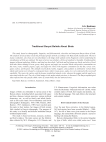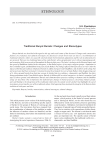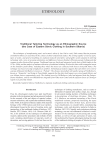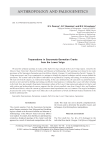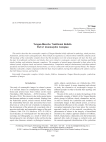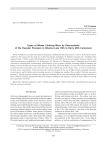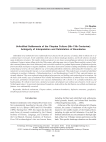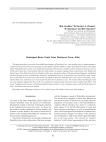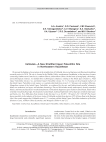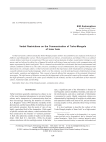Статьи журнала - Archaeology, Ethnology & Anthropology of Eurasia
Все статьи: 351
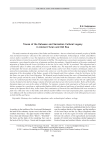
Traces of the Dahaean and Sarmatian cultural legacy in Ancient Turan and Old Rus
Статья
This study examines the migrations of the Dahae and Sarmatians—the two related early nomadic peoples of Middle Asia and Eastern Europe—directed to the south and west of their homeland. Archaeological, written, and folkloric sources make it possible to trace the migrations of the Dahae and Sarmatians over several centuries preceding the spread of Islam in Central Asia and of Christianity in Old Rus. The study focuses on mortuary monuments, temples, and sanctuaries, cross-shaped in plan view, of migrants and their descendants. A detailed analysis of the major southward migration of Dahae from the Lower Syr-Darya in the late 3rd to early 2nd BC is presented. This migration had a considerable effect on ethnic and cultural processes in Middle Asia. The migration aimed at conquering the lands of Alexander the Great’s descendants, who were rapidly losing control over them. Features of Dahaean culture are noticed in town planning, architecture, mortuary rites, armor, etc. over the entire territory they had captured. Southward migration of the descendants of the Dahae—people of the Kaunchi and Otrar cultures—from the Syr-Darya, led by the Huns, was part of the Great Migration. The Kaunchi people headed toward the oases of Samarkand and Kesh, the Otrar people toward the oasis of Bukhara, and those associated with the Dzhetyasar culture toward the Qarshi oasis. It is demonstrated that while the cross-shaped plan view of religious structures turned into the eight-petaled rosette, the fu neral rite did not change, remains of burials and charcoal are observed everywhere. Relics of the ScythoSarmatian legacy are seen in the culture of Old Rus. For instance, remains of the sanctuaries of Perun are walls and ditches arranged in a cruciform or eight-petaled fashion, fi lled with charcoal and bones of sacrifi ced animals, with a statue of the supreme Slavic deity, in the center. Early sanctuaries of Perun in Kiev and Khodosovichi were cruciate in plan view, while later ones on the banks of the Zbruch and the Volkhov rivers had octopetalous plans. Apparently they were infl uenced by the architectural traditions of Dahae and Sarmatians, who took part in the ethnogenetic processes in both Old Rus and Turan.
Бесплатно
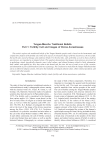
Tungus-Manchu traditional beliefs. Part 1: fertility cult and images of divine ancestresses
Статья
This article explores the traditional beliefs of the Tungus-Manchu peoples and is based on the hermeneutic and comparative analysis of the fertility cult. Some of its aspects are related to images of divine ancestresses, the tree of life, the hearth cult, ancestral lineage, and animistic beliefs. For the fi rst time, cults of fertility, as well as those of divine ancestresses, are regarded as an integral whole. This analysis demonstrates that images of ancestresses are preserved in mythology, rituals (specifi cally domestic ones), tribal culture, and cultural features related to birth, shamanism, ludic culture, and applied art. Also, they relate to the hearth cult, fi re rites, the tree of souls or tree of life, creation, and shamanism as part of folk medicine and rites of passage. The conclusion is made that the Tungus-Manchu fertility cult is an inherent religious system, relevant to the mentality, archetypal cultural values, ethno-cultural specifi city, and contacts with other peoples.
Бесплатно
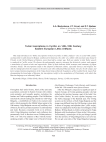
Turkic inscriptions in Cyrillic on 14th-15th century eastern European Lithic artifacts
Статья обзорная
Бесплатно
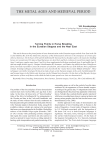
Turning points in horse breeding in the Eurasian steppes and the Near East
Статья обзорная
Бесплатно
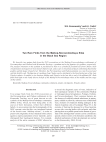
Two rare finds from the Maikop-Novosvobodnaya sites in the Black Sea region
Статья обзорная
Бесплатно
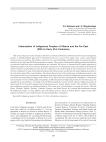
Urbanization of indigenous peoples of Siberia and the Far East (20th to early 21st centuries)
Статья
Бесплатно
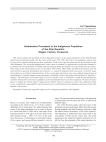
Статья
This article explores the specifi city of the urbanization process in the native population of the Altai Republic and assesses its principal trends over the course of the years 1926–2020. The focus is on quantitative aspects such as the growth of urban settlements and their population. I look at the ways the urban network has developed in the Altai Mountains. The only urban administrative center shows a potential for agglomerative growth and continues to accumulate the rural population. Townships that had emerged during the Soviet period were unattractive for natives. Three stages in the urbanization process are described: 1926–1950s, 1960–1980s, and 1990 to the present. Over the entire period in question, urbanization was extensive, i.e. caused by migration from rural areas. At the fi rst stage, the key factor was political (collectivization). In the second stage, the factors were socio-cultural (attractiveness of urban lifestyle), economic (higher income and greater availability of jobs), and political (the abolition of “futureless” villages). The main factor at the third stage was socio-economic crisis. A conclusion is made that the potential for extensive urbanization in the native population of the Altai Republic has not yet been exhausted. The most attractive places to migrate are still the region’s capital and its suburbs. However, migration to other cities of Russia is likely to rise. A prediction is made that the role of intensive factors of urbanization in the indigenous population of the Altai Republic will increase.
Бесплатно
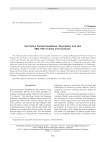
Ust-Tsilma female headdress: description and use (mid 19th to early 21st century)
Статья обзорная
Бесплатно
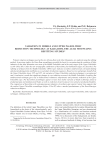
Статья научная
Primary reduction techniques used at the site of Kara-Bom in the Altai Mountains, are analyzed using the refi tting method. In previous studies, the Kara-Bom assemblages provided the basis for reconstructing the evolution of lithic industries in the Altai Mountains over most of the Middle Paleolithic and at the early stages of the Upper Paleolithic (ca 60–30 ka BP). Under the new stratigraphic subdivision of Kara-Bom, four habitation stages are described. The refi tting of artifacts from the Middle Paleolithic (MP2) layer indicates Levallois unidirectional convergent fl aking aimed at producing points and blades as a co-product of reduction sequences. Based on cores and groups of spalls from the Upper Paleolithic layers UP2 and UP1, the variation of Upper Paleolithic reduction techniques is reconstructed and a conclusion is made that signifi cant changes in core reduction occurred: the Middle Paleolithic (Levallois) fl at unidirectional technique gave way to bidirectional volumetric subprismatic and prismatic reduction of the Upper Paleolithic type. The Kara-Bom assemblages appear to have been stable variants of blade technology aimed at producing large and medium-sized blades as well as reduction of narrow-faced cores aimed at producing bladelets. The comparison of Kara-Bom with contemporaneous industries of northern and eastern Central Asia suggests that the earliest Upper Paleolithic assemblages (before 35 ka BP) show a marked predominance of the Kara-Bom-type reduction techniques.
Бесплатно
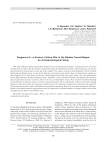
Vengerovo-2-A Krotovo culture site in the Baraba forest-steppe: an archaeozoological study
Статья научная
This study addresses faunal remains from Vengerovo-2 in the Baraba forest-steppe—a Bronze Age site associated with the Krotovo culture. We describe the origin of the sample, the distribution of bones in the living space, the species and skeletal parts represented, and the age of the animals. The sample consists of small fragments, which are likely butchering and kitchen waste, as well as the leftovers of production and rituals. Bones of domesticated animals are more frequent (62 %) than those of wild ones. Skeletal parts from utility pits (pelvic bones, ribs, and appendicular bones) differ from those found in production areas—mandibles, crania, and entire skeletons. Presumably, pits contained food, and production areas were places where work was accompanied by rituals. The reconstructed animal breeding system indicates its domestic nature, centered on sheep and goats, with a small number of horses and cattle. Hunting large prey (elk and roe deer) was important, and the same is true about fur animals (fox and marten) and waterfowl. The procurement of peltry, hides, and leather were principal occupations. Bone tools were made mostly from elk bones. Results of correlation analysis suggest that in terms of composition, the faunal sample was largely similar to those from contemporaneous Krotovo and Yelunino sites.
Бесплатно

